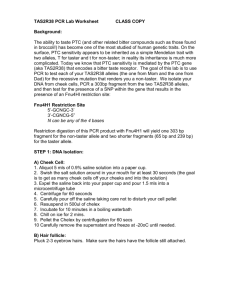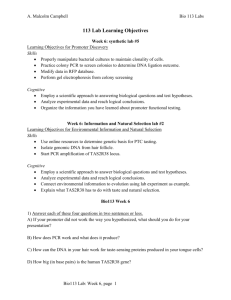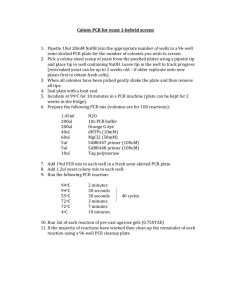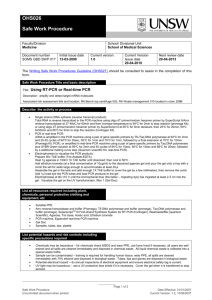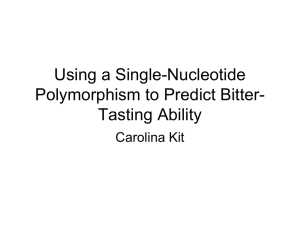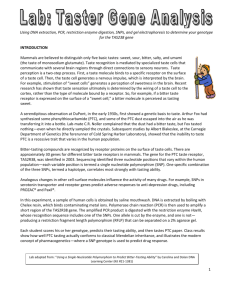TAS2R38 PCR Lab Worksheet
advertisement
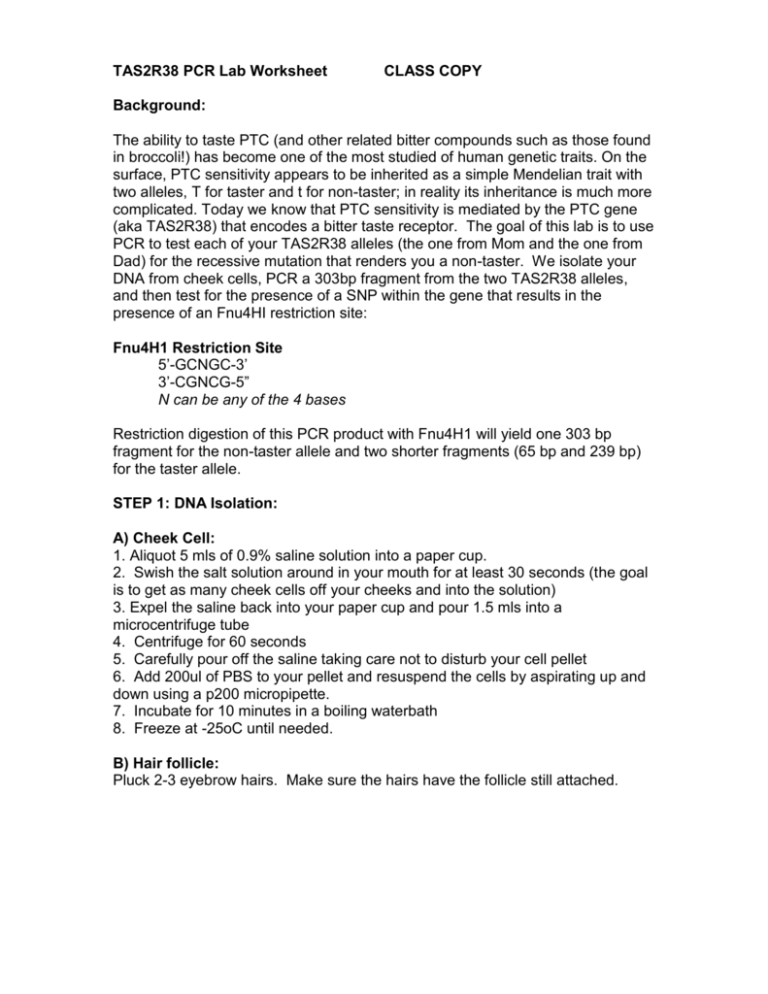
TAS2R38 PCR Lab Worksheet CLASS COPY Background: The ability to taste PTC (and other related bitter compounds such as those found in broccoli!) has become one of the most studied of human genetic traits. On the surface, PTC sensitivity appears to be inherited as a simple Mendelian trait with two alleles, T for taster and t for non-taster; in reality its inheritance is much more complicated. Today we know that PTC sensitivity is mediated by the PTC gene (aka TAS2R38) that encodes a bitter taste receptor. The goal of this lab is to use PCR to test each of your TAS2R38 alleles (the one from Mom and the one from Dad) for the recessive mutation that renders you a non-taster. We isolate your DNA from cheek cells, PCR a 303bp fragment from the two TAS2R38 alleles, and then test for the presence of a SNP within the gene that results in the presence of an Fnu4HI restriction site: Fnu4H1 Restriction Site 5’-GCNGC-3’ 3’-CGNCG-5” N can be any of the 4 bases Restriction digestion of this PCR product with Fnu4H1 will yield one 303 bp fragment for the non-taster allele and two shorter fragments (65 bp and 239 bp) for the taster allele. STEP 1: DNA Isolation: A) Cheek Cell: 1. Aliquot 5 mls of 0.9% saline solution into a paper cup. 2. Swish the salt solution around in your mouth for at least 30 seconds (the goal is to get as many cheek cells off your cheeks and into the solution) 3. Expel the saline back into your paper cup and pour 1.5 mls into a microcentrifuge tube 4. Centrifuge for 60 seconds 5. Carefully pour off the saline taking care not to disturb your cell pellet 6. Add 200ul of PBS to your pellet and resuspend the cells by aspirating up and down using a p200 micropipette. 7. Incubate for 10 minutes in a boiling waterbath 8. Freeze at -25oC until needed. B) Hair follicle: Pluck 2-3 eyebrow hairs. Make sure the hairs have the follicle still attached. STEP 2: Set up the PCR Reaction 1. Add the following to your mini PCR reaction tube: 10 ul taq Buffer + MgCl2 (10X) 10 ul 10mM Nucleotides 10 ul of reverse TAS2R38 10mM primer 10 ul of forward TAS2R38 10mM primer 0.5 ul taq polymerase 10 ul pcr grade H2O 1ul of cheek DNA or 2-3 eyebrow hairs ___ 50ul total 2. Add your tube to the PCR machine and start the reaction. The PCR machine should be set for the following cycles: Initial Denature – 94oC 3 mins Denature Anneal Extend Repeat 30X 94oC 30 seconds 550C 30 seconds 72oC 1 minute Final extension 72oC 10 mins Hold at 4oc indefinitely STEP 3: Set up Diagnostic Restriction Digest. TAS2R38/Fnu4HI 13 μl PCR Rxn. 1.5 μl 10X NEB Buffer #4 0.5 μl Fnu4 HI 15 μl Total, incubate at 37oC for 1 hour STEP 4: Gel electrophoresis for each bench: 1. Prepare 30 mls 2% agarose gel in TAE buffer. 2. Cool and add 1ul/10 mls agarose SYBR stain. Mix and pour the gel. 3. Prepare a Low Molecular Weight marker tube (1ul LMW marker in 9ul TAE buffer + Sample Loading dye. 4. Prepare your pcr sample by adding 3ul of sample loading dye to the Fnu4HI digested pcr sample. 5. Record your sample position KEY on your worksheet and run gel at 100v. 6. Record your results and submit them with your focus question answers. PCR LAB Focus Questions Name____________________ 1: Describe the overall purpose of PCR. 2. List the components/ingredients of your PCR reaction. For each component describe why it is needed. a) b) c) d) e) f) 3. What are the three main steps of the PCR reaction and what are their purposes? a) b) c) 4. What does it mean if you only see a 303bp band on your gel? 5. What does it mean if you see a 65bp and 239bp fragment in your gel? 6. What does it mean if you see a 65bp, 239bp, and a 303bp fragment in your gel? 7. This experiment had no controls for the PCR reaction. Describe suitable positive and negative controls that would convince you, the experimenter, that the PCR reaction was capable of amplifying the TAS2R38 alleles and that the ingredients of the reaction were uncontaminated with human DNA. Positive: Negative: 8. Record your tables results. Don’t forget to provide a key. Also annotate your results diagram with as much information as necessary to provide an understanding of what each band means. Sample KEY 9. What is your TAS2R38 allele genotype? Results
